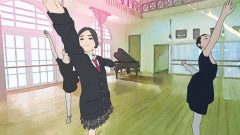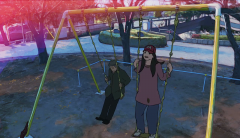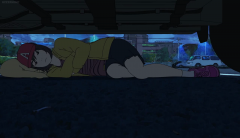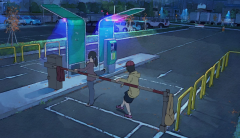Welcome to the third installment of World Animation section, but this time we head back to Japan for my favorite anime movie out of last year. If anything, I have always wanted those reviews to be a recommendation if you want to look for something different. So if there is anyone who would check out the films after reading those reviews, then I consider those posts a success. I know myself checking out a wide range of movies just because I read reviews that I enjoyed, so I hope I could offer the same here. Unlike those first two movies that I happened to watch in certain film screenings, from now on those movies that I review are available online or on streaming, so if you feel interested then by all mean go check it out yourself.
The Murder Case of Hana & Alice (or just simply The Case of Hana & Alice) is a prequel of a 2004 live-action movie Hana & Alice. The film divides into two separate parts, which contains even different sets of characters besides the titular Alice. We follow every steps of Alice as she familiars herself with the new environment in the first part; noticing the mysterious neighbor who spied on her (that would be Hana), being bullied in class for breaking the “curse seal”, having a chance to play ballet, meeting her father, participating in relay, and investigating a superstitious “murder case”. The second half we have her teaming up with Hana in an attempt to find whether the real victim was dead or alive, which leads to the many misadventures along the way.
If there is one thing that you immediately notice while watching this film is that the film looks and feels more like a live-action movie than anime. This is true in a sense since the director Shunji Iwai is famous for his live-action films and The Case of Hana & Alice was his first anime attempt. The shots compose is more of live-action sensibility than animation as well. Take for example the motifs of tracking the characters walking through the streets in a profile shot; while we have that kind of shot in anime, it’s usually used very quickly to show the characters talking to each other. Here in the film they use a good 10-20 seconds just to follow those characters literally just walking, either alone or together. The character designs, since they are modeled from real actresses, look more realistic than our usual anime designs. The color is always on bright scheme, with the mixture of real life building and pink/green-dominated background. It produces a more impressionist look and honestly I like the look of the movie. The music is easily one the best component out of this film, which composed by the director himself. It contains both piano score and violin score resembling a ballet score. If you close your eyes and just listen to the music, you can really feel the flow of the music and the mood it creates. It’s that good.
In addition, the decision to make this film an animated one was more of practical choice than artistic choice. The director wanted to use the same actresses from the original movie to display an even younger version of them, as a result he had to use rotoscoping to avoid ageing the actresses. To put it simply, rotoscoping is a process of filming live action footage (with real actors of course), then retrace it frame by frame by either re-drawn it or using computer software. Rotoscoping has been used before in anime, quite controversially even, in Flowers of Evil, to suggest an eerie and uncomfortable sense to our viewers, but in this case, the use of rotoscoping produces a very different outcome: a floating sense. That floating sense plays both as its strengths and as its shortcomings. On a plus side, this suits the most for ballet dancing, since you know, ballet dancing is already like floating across the floors. Many of the ballet sequences are easily the highlights of the movie, both visually and as a statement of how to use the technique right. On the negative side though, the weight of the characters always seems off, as a result we feel the characters “just floating” in many moments, most noticeably the first sequence where Alice falls off from her window and was “catch” by the worker, or later whenever Alice’s running. On other notes, the disparity between characters who were drawn from actual actors and those fictional characters is just jarring. The designs of the worker mentioned earlier or the triplets with bikes in the end felt really like they came from Tintin universe (with big-dot eyes and cartoon face) and to put it together with a much more realistic designs of the mains, you feel like you’re watching two different movies at the same time.
The biggest selling point of the film is, of course, the characters themselves and the dynamic between the two main girls. On that front, the film shines the brightest. This is the kind of characters I love to follow, not because they are the deepest, but because they’re full of identity. There are many vivid little moments that showcase this quality, as mundane and realistic as possible. From Alice punching the book written by her mother in a bookstore, to a moment where she found the last piece of snack, to the moment where the two girls practicing ballet out at night. Make no mistake, the staffs really love their characters and we feel that love throughout the movie. They are not your typical teenager high school protagonists, Alice is a girl that acts on impulse, she’s direct and doesn’t afraid to speak her mind; but she’s surprisingly down to earth and sincere as well or Hana is not your typically shut-in character, as she’s actually smart and quick-wit, and her guilt that she might be responsible for the death of her close friend makes her a more realized person than most other main characters we see in anime shows. Furthermore, they bound off each other very well, mostly because they have so different personalities, yet they can share the pain to each other. The other side characters, in general, provide enough charms and again, “personality” to make them stand out too: Alice’s mother is wise enough but often shown as childish, Mu is fantastic with her unique-but-nonsensical quirks.
Another note that I find really interesting is that the whole film is decidedly female-centric cast, with the men only appear as either faraway (both Alice’s father and Yuda) or as weak and dependent (Alice’s father mentioned that he didn’t have a mindset to become a top runner, the bullying boy who reveals that he does it to save face, Yuda who is insecure about love and the idea of commitment). The only real male cast that was portrayed in different light is the old man. He’s representing the contrast between his old-self with the youthful, full-of-life of Alice. The sequence that speaks best to that idea, when Alice playing on the swing, stating how long it has been since her last play (2 years), the old man just sits quietly there in the next wing, his body feature looks no different than the old man in Ikuru, he told her that it has been 40 years since he played, because it was the time when his daughter was still in elementary school. This sad, melancholic tone mix in so well with the youthful of Alice. This is really the heart of The Murder Case of Hana and Alice- a film that celebrates the youthfulness, of how it’s like to feel young and enjoy the little moments of your life.
It’s criminal that The Murder Case of Hana & Alice slipped under the radar of most of anime fan. Surely it doesn’t look like your typical anime but I will say that there won’t be any anime like this in the near future. This is a rarity even among anime fandom. I haven’t watched the original live-action film, but surely after watching this I’m eager to check out the movie, just so that I can spend more time with those characters again.
Next post I will review the best written anime movie out of last year. And this time it might be the one you think it is. Stay tune!
~SuperMario~





I don’t think people hate rotoscoping just for the sake of it being different. It’s generally the easy way out of doing complex animation, and there’s programs out there that automatically do it for you so even if a realistic style was artistically needed you don’t have to be lazy and rotoscope. Look at Mushishi, that series is 1000x more eerie and atmospheric than Flowers of Evil with its beautiful animation and art than something as lazy as rotoscoping
There’s obviously a huge difference between Flowers of Evil and the movie in production but rotoscoping is something almost anyone can get into with ease like this: https://www.youtube.com/watch?v=dIZHUyVzx7A
so artistic or not, it shouldn’t be praised.
erm, I know that before there were a software for rotoscoping, people had to draw it frame by frame so it was also a pain-taking process back then, to the point where they mainly use the technique for extremely complex movements (like, if I recall correctly, in Cinderella when she had her new dress), and only shorts or music video was produced (Aha’s Take on Me is a good example) https://www.youtube.com/watch?v=djV11Xbc914
But with the rise of computer animation, sure rotoscoping become more and more easy to use. I guess now the real question is how they gonna use it. Richard Linklater’s films Waking Life and A Scanner Darkly smartly used the technique to produce dream-like state of mind, or Flowers of Evil used it to create a uncanny and ugly sense…As far as I see, if they have a good reason why to use rotoscoping, I can’t see any problem why it should not be praised.
I understand where you’re coming from, yes I also care about the context of how they use rotoscoping although clearly I dont think its worth any sort of praise (besides the decision to use rotoscoping, the technique itself isnt really there). Flowers of Evil seemed like it couldve worked equally well or maybe even better with regular animation just in my opinion.
What are some cases where you think rotoscoping is better? Because I gave Mushishi as an example where its even more dream-like than if they’d used rotoscoping.
Thanks for all these constructive comments WolfeTCG. In case of Mushishi, it’s best the way it is imo, because the world they created is not dreamlike at all but very grounded. In fact Mushishi feel as a whole very grounded, I don’t think it would work too well if it rotoscopes.
Examples? Interesting. If you use rotoscoping to explore the connection between real-world/dream, then Satoshi Kon’s works would suit the best. But then his works alone are already visually unique that using this technique would not add up anything. Other aspect of rotoscoping I really like to look at is the acting (which you can’t really judge this to other types of animation), so with that in mind I’m intrigued to see how Monster would look like if it was acted like a live-action than rotoscping it. Another example would be using rotoscope (real human faces) to raise the theme about human/robot relationship. In that sense I think Time of Eve would be the best fit, with Ghosts in the Shell would be a solid alternative (but no, we already have enough of Gits)
Hey I love Filthy Frank, don’t talk shit b0ss.
I liked the review. Definitely, the movie has great looks. I’ll watch it!
And I believe Flowers of Evil was the best production to use rotoscoping. But a lot of people didn’t understand the idea of the series.
I’m usually not a fan of murder mysteries, but I think I might check this one out.
oh, the “murder case” in the film is as mundane and dull as it can get, but this is a part of its charms. In other words, no actual murder mystery. Go see it by yourself haha
Nice review, def going to check it out. Can’t believe I missed this.
@Tarsio @madhater: Thanks and don’t forget to tell us what you think after watching this movie okay?
I really liked and I agree with you in everything, @SuperMario.
I watched the animation and the original live action movie. It is great how the characters move in the scenes. I think the story of the animation prequel is more focus and entertaining. The live-action is kind of dispersed, but it is very interesting too. And is good to see the actress real expression.
Sometimes the Hana character reminds me a lot of Greta Gerwig in Frances Ha. And the two movies are about friendship and ballet.
Well, Frances Ha has to be one of my favorite characters in the last few years, they way she’s so flawed but so real to life; so I’m pretty much on boat with you here. I haven’t watched the live-action movie so I can’t say for sure but for me it’s Alice who more like Frances Ha (she’s the one who does ballet, after all). If the original movie keeps dwelling about their relationship, I have no doubt that I will enjoy it as well.